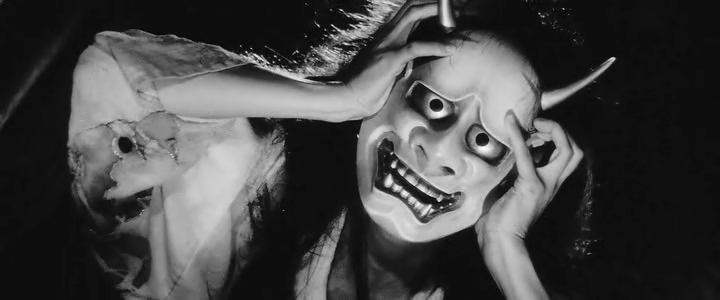When the Twitter feed for Disney+ published a thread listing every title subscribers could find on the new service, some pop culture fans cheered. But even as commenters celebrated the chance to revisit pre-’70s family films like Snow White and the Seven Dwarves or The Story of Robin Hood and His Merrie Men, others noted the absence of early films in other genres, especially from Disney’s newly acquired 20th Century Fox back-catalog.
On one hand, this lack shouldn’t be a surprise. Disney+ bills itself as a family service, and there are plenty of other outlets where one can find and stream movies. On the other hand, a number of critics have found that these services tend to overwhelmingly favor recent cinema over the old. Sure, Netflix still carries gems like the Kino Lorber collections of films directed by women and African Americans, and you can rent foundational works like Fritz Lang’s Metropolis or The Wizard of Oz through Amazon. But these exceptions prove the rule that subscription services tend to primarily carry movies from the past thirty years.
As a result, the public has fewer opportunities to explore and learn about the history of cinema. Fewer and fewer modern viewers will get the chance to wrestle with films that built the foundations of the movies they love, or come to understand filmic language that predates the modern blockbuster era, let alone the New Hollywood revolution of the ’70s. In short, restricted access to first 70 years of movies makes us all a little less literate in what has become the dominant storytelling medium.
That’s particularly troubling in October, when audiences tend to make a point of not only watching horror movies, but of expanding their horizons in search of new thrills, tales of suspense, and haunting visuals. Now more than ever, movie fans want to watch important films in the genre or discover surprising works they’ve never heard about. But as subscription-based streaming services continue to overtake rental stores, indie and arthouse theaters, and cable, it becomes harder and harder for an enterprising viewer to broaden their tastes.
But it’s not impossible! You can still stream great horror classics, if you know where to look—and this list offers some great places to start. I’ve left off a few obvious choices, such as Alfred Hitchcock’s Psycho (1960) or George R. Romero’s The Night of the Living Dead (1968). These movies laid the foundations of modern horror, so you should absolutely watch them, and you can find them fairly easily on most streaming rental services.
But this particular list focuses on films included in the base subscriptions the Criterion Channel and on free services Kanopy, tubi.tv, and Vudu, so read on if you want to have yourself a classic horror marathon this Halloween!
The Cabinet of Doctor Caligari (1919)

Available on Kanopy, The Criterion Channel, and Tubi.tv
It can be hard for modern movie fans to connect with early cinema. Up until the mid-’60s, performances tended to big, the sets and effects less than convincing, and basic elements like credits and title cards were done differently. That is doubly true of silent movies, which relied on theatrical acting, written subtitles, and monochromatic tints to compensate for the lack of spoken dialogue.
All of that said, The Cabinet of Doctor Caligari may be more accessible than movies made even fifty years later. Not only does Caligari’s Frankenstein-like plot—in which a hypnotist (Werner Krauss) forces a somnambulist (Conrad Viedt) to do his bidding—still resonate with viewers, but the movie simply looks fresh and exciting, from a visual perspective. An exemplar of the German Expressionist style, director Robert Wiene eschews realism for sharp angles and ridiculous proportions, creating landscapes that wouldn’t be out of place in an animated cartoon or a Tim Burton movie.
But despite its more recognizable elements, Doctor Caligari still manages to unsettle. Wiene’s camera captures the full absurdity of his story’s world, from the hypnotist’s scheming smile to the expressionless face of the entranced sleepwalker. The scene in which the somnambulist carries Calagari’s victim across a jagged skyline rightfully belongs on any list of all-time scariest movie moments—a position it’s held for a full century.
Nosferatu (1922)
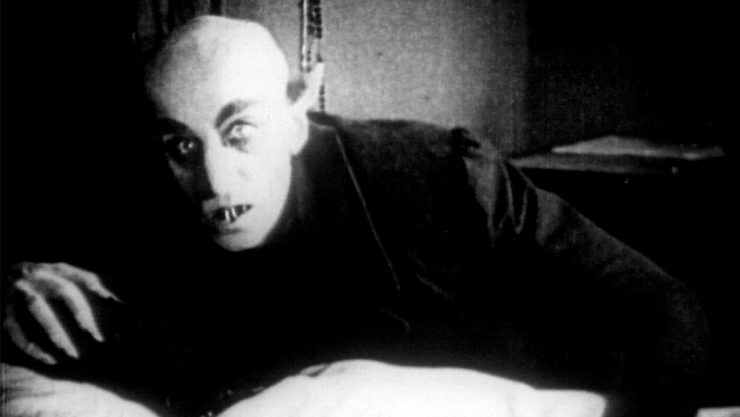
Available on Kanopy, The Criterion Channel, and Tubi.tv
Introduced in Bram Stoker’s 1897 novel, Count Dracula remains one of the world’s most popular monsters. When audiences imagine the vampire, they tend to picture the suave aristocrat Bela Lugosi popularized on stage and on the screen, or maybe even the towering supervillain Christopher Lee portrayed for Hammer Films. But even if they don’t know his name, moviegoers are just as likely to picture Dracula’s bestial double, Count Orlok.
Orlok is the titular Nosferatu of the F. W. Murnau-directed unauthorized adaptation of Stoker’s novel. Unable to secure adaptation rights for Stoker’s widow, Murnau and his screenwriter Henrik Galeen changed the setting, character names, and a few plot details to make their own (somewhat) distinct vampire story. The basic plot remains the same, with Jonathan Harker analogue Thomas Hutter (Gustav von Wagenheim) trying to save his fiancée Ellen (Greta Schröder) from Orlok, with the help of Professor Bulwer (John Gottowt).
Galeen’s revision sidelines the Van Helsing-esque Professor Bulwer, increasing focus on the bumbling and fearful Hutter, who is easily overshadowed by Orlok. But one can’t really blame Wagenheim for not making Hutter more memorable; it’s hard to imagine anyone who could shine next to Max Schreck’s feral performance. With pointed ears and flared eyebrows jutting from his bald head, and a black overcoat that makes him seem towering even when hunched, Orlak feels like a true creature of the night, a monster whose unsettling strangeness Lugosi and Lee’s suave, sinister Draculas could never fully approach.
Vampyr (1932)
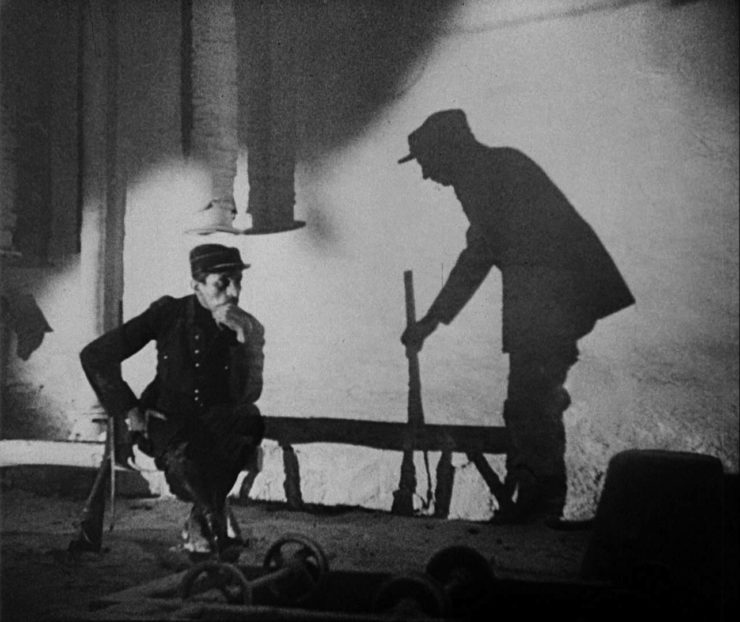
Available on Kanopy and The Criterion Channel
If Nosferatu works because of its central monster’s presence, Carl Theodor Dreyer’s moody Vampyr works because of its monster’s absence. The titular bloodsucker rarely appears on screen, but we sense its power behind the movie’s many phantasmic horrors. Despite its simplistic plot, featuring a nebbishy outsider entangled with a noble family caught in a vampire’s thrall, Vampyr features bizarre dream sequences that stand up to anything David Lynch might make today.
While technically a sound film, Dreyer keeps spoken dialogue to a minimum, relying instead on the skills he developed making meditative silent films such as The Passion of Joan of Arc, letting title cards and reaction shots carry the story. The approach results in a distancing effect on the audience, never allowing us to fully understand the story.
One of the best examples of this effect occurs when protagonist Allan Gray (Nicolas de Gunzburg) walks outside after finding a mysterious package by his bedside. Literal shadows greet Gray as soon as he exits the building, in the form of an opaque figure dancing in a pond’s reflection or in the shade of a soldier, ambling over to sit behind its human double. We don’t know why Gray continues to move through the building or what he thinks of the bizarre figures he sees, but that only adds to the mounting dread. Like us, he’s caught in a strange and inexplicable dream, and cannot get free.
Cat People (1942)
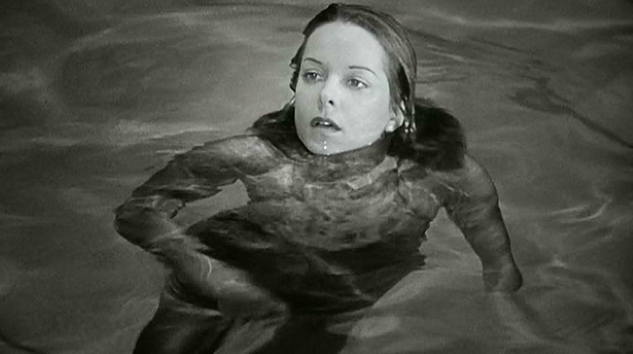
Available on The Criterion Channel
As impressive as Vampyr may be, no one ever did horror atmosphere better than producer Val Lewton. While working at RKO Pictures, Lewton spearheaded a number of films that traded not on the recognizable monsters available to Universal but on unique narratives told through a thick foggy haze. Although Lewton’s output includes the Jane Eyre re-imagining I Walked With a Zombie and the Edgar Allen Poe-inspired Bedlam, his masterpiece came with his RKO debut, the Jacques Tourneur-directed Cat People.
On the surface, Cat People has all the makings of a standard werewolf tale, featuring Serbian-born fashion designer Irene (Simone Simon), who falls for and marries American Oliver Reed (Kent Smith), despite her conviction that she descends from a race of panther people. Convinced that giving into lust will spark the transformation, thereby killing her husband, Irene refuses sex with Oliver, who soon develops a connection with coworker Alice (Jane Randolph).
As in all of Lewton’s best films, Cat People uses suspense and the implication of a possible threat to great effect, terrifying the audience by suggesting danger instead of actually showing it. In the movie’s best scene, Alice goes for a late-night swim in an abandoned swimming pool and begins to suspect that she’s not alone. Through the steam rising from the water’s surface, we see only the shadow of a panther, and she can hear the beast growl and snarl. But she cannot see, she does not know if and when it will attack—and neither do we.
The Hitch-Hiker (1953)
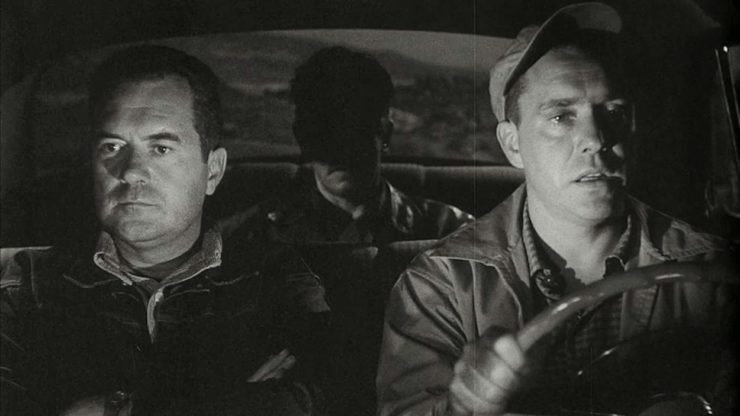
Available on The Criterion Channel and Tuvi.tv
With its ripped-from-the-headlines plot, The Hitch-Hiker feels remarkably modern for a movie released in 1953. As played by William Talman, the titular killer Emmett Myers is a lazy-eyed drifter who solicits rides from travelers before leaving them for dead. The movie opens with Myers’s killing spree (and the police investigation) already well underway, when buddies Roy (Edmond O’Brien) and Gilbert (Frank Lovejoy) decided to offer a stranger a ride—unaware that they’ve put their lives in danger.
Myers toys with Roy and Gilbert, and thwarts their attempts to escape, pitting the friends against one another as he plays out his mind games. That’s a great premise, though it begins to lose steam over time, and the movie feels stretched out even at 71 minutes. However, director Ida Lupino does make the sun-soaked desert feel as terrifying as any haunted house and stages some truly inventive shots along the way. In one of the most tense moments, the camera takes a first-person view to stare down a pistol sight as Myers forces Gilbert to shoot a can thats held in Roy’s hand. We watch through Gilbert’s perspective as the gun waivers with uncertainty between the target and his best friend.
In that moment, the monster isn’t a changeling or a vampire, but a terrible human being cruel to other humans, without an supernatural explanation for his actions. It’s that devotion to stark realism and austerity that allows Lupino to create a horror story that haunts viewers on a deeper, more primal level.
A Bucket of Blood (1959)
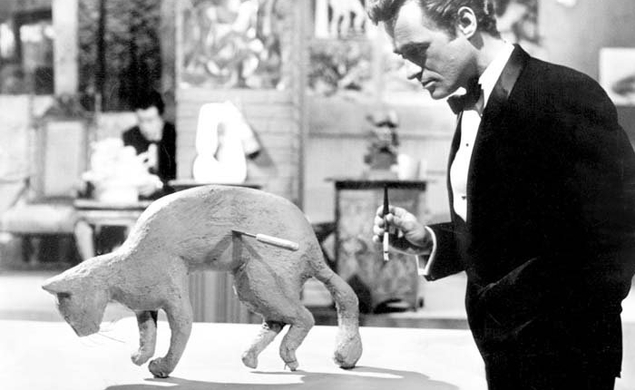
Available on Kanopy, Vudu, and Tuvi.tv
Any fan of genre cinema knows Dick Miller. A quintessential “that guy,” Miller appeared in over 180 movies. While his credits included some mainstream movies like Gremlins and The Terminator, Miller could be most often found in B-movies like Chopping Mall and The Little Shop of Horrors. For that reason, it’s appropriate that Miller’s only starring role would be in a movie directed by Roger Corman, the king of the genre cheapie.
Miller plays Walter Paisley, a dimwitted busboy who longs to be express himself as powerfully as the beatniks in the club where he works. After hiding the body of a cat he accidentally killed in plaster and passing it off as a sculpture, Paisley gets his first taste of artistic respect. This newfound attention leads to new connections within the beatnik elites—and a need to find new victims for his next sculptures.
While the movie’s specific references to poets in black turtlenecks or earnest folkies might be lost on today’s viewers, the vacuous pretension of the art world remains an evergreen satirical topic and the jokes largely land. More importantly, no matter how much the movie goes for humor instead of horror, the sweet-natured Paisley’s transformation into a wild-eyed murderer will always be disturbing to witness.
Eyes Without a Face (1960)
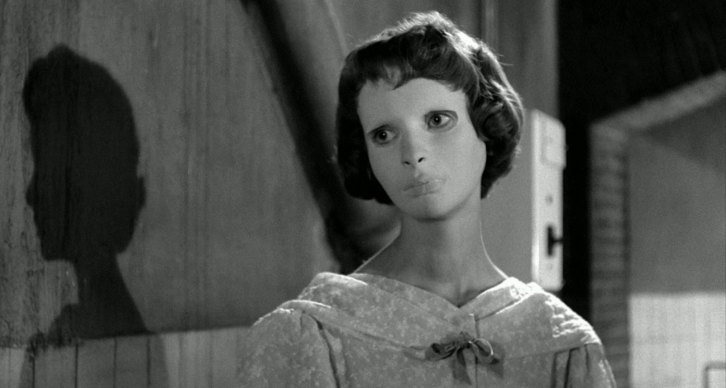
Available on Kanopy and The Criterion Channel
For me, nothing is as scary as a faceless terror. If the eyes are the windows to the soul, and our faces the way we reveal ourselves to one another, a blank, featureless, or obscured visage suggests something fundamentally inhuman, soulless, uncanny. Apparently, I’m not alone in experiencing this fear, as French director Georges Franju’s Eyes Without a Face derives scares from the mere image of a faceless woman in a featureless mask.
This woman is Christiane (Édith Scob), damaged but beloved daughter of plastic surgeon Génessier (Pierre Brausseur).Her face mutilated in a car accident, Christiane stays trapped in her father’s house while he searches for the perfect face to graft onto his daughter.
Eyes Without A Face builds tension by contrasting Christiane’s unsettling visage with Scob’s demure performance. Like the songbirds that keep her company, Christiane is a beautiful creature trapped by the expectations of those around her. She is still human, even when staring from behind her empty mask, but her father refuses to allow her a life beyond his mad experiments. Franju underscores the evil done in pursuit of purity by contrasting Christiane’s delicate nature with the film’s gory and violent scenes, including a surprisingly graphic face transplant.
Carnival of Souls (1962)
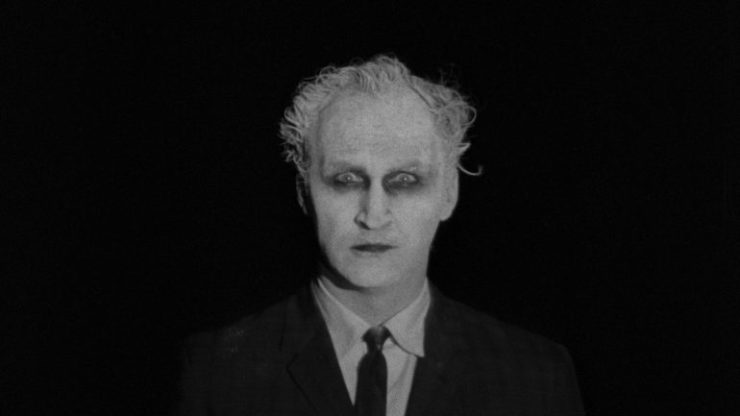
Available on Kanopy, The Criterion Channel, and Tubi.tv
For most of his career, director Herk Harvey made only industrial films (including the Rifftrax classic Shake Hands with Danger), developing a dry style that seems like a poor fit for the horror genre. But it’s that dispassionate, almost inhuman approach, that makes Harvey’s one narrative film, Carnival of Souls, so effective.
Carnival of Souls begins without fanfare, matter-of-factly following Mary Henry (Candace Hilligoss) as she drives her car off a bridge. We watch her pull herself out of the river and go on to rent a new apartment, but we don’t know who she is or what’s motivating her. She’s a mystery even before she’s followed by a pale-faced man with wild tufts of hair (played by Harvey himself).
Most movies would suffer from characters who behave in a mechanical and unbelievable manner, but not Carnival of Souls. As the spirit world begins bleeding into the world of the living, both become strange—a strangeness we feel and understand without the need for explanatory dialogue.
Blood Feast (1963)
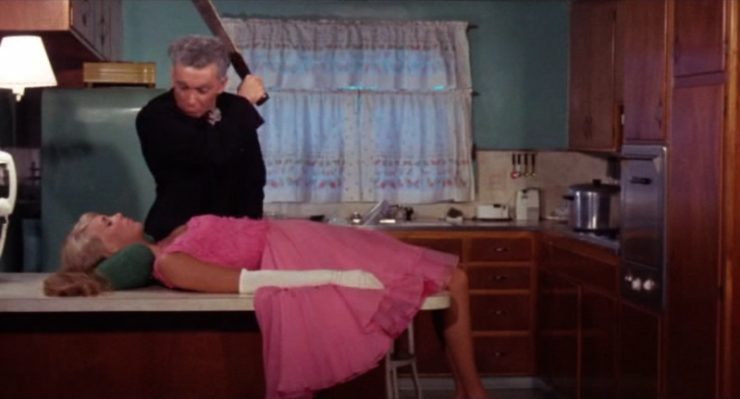
Available on Kanopy, The Criterion Channel, and Tubi.tv
When horror detractors dismiss the genre, they often point to gore and violence as signs of depravity, implying that modern movies are somehow worse than the classics. Anyone making that argument must be unfamiliar with the “Godfather of Gore,” Herschell Gordon Lewis, whose stomach-turning tales took full advantage of late-Sixties technicolor to cover the screen with quantities of unreal red blood.
To be frank, there’s not much to the plots of Lewis’s movies, even his greatest film, Blood Feast. There’s something about a caterer (Mal Arnold) killing and eating women as part of a sacrifice to the goddess Ishtar, but no one’s watching this movie for its story. We’re watching for the blood and guts, and Blood Feast serves up a heaping helping.
Sequences of the caterer removing a victim’s brain or digging out a tongue aren’t remotely realistic, especially by today’s standards, but they are memorable. Modern filmmakers may be able to recreate vivisections with almost medical accuracy, but their efforts will never feel as daring or subversive as those by Gordon. Blood Feast exists to shock in a way that no movie after would be able to do quite as well, even if nothing about the movie lingers in the viewer’s mind quite like that shock itself. At the very least, Gordon’s films handily dispels the misconception that old movies are boring.
Onibaba (1964)
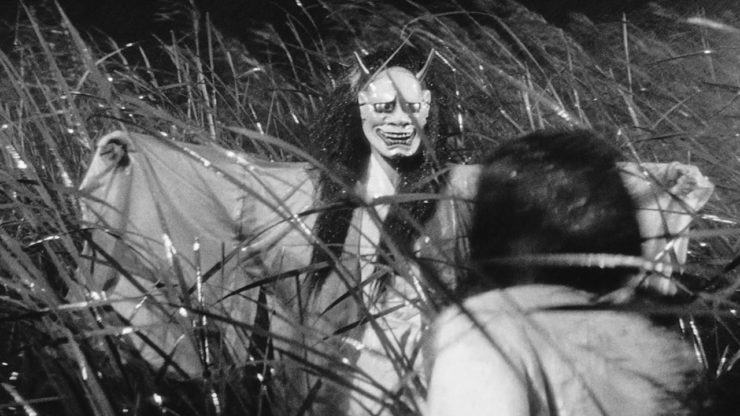
Available on Kanopy and The Criterion Channel
The Japanese ghost story Onibaba may not be a household name, but most horror fans have at least seen the film’s famous demon mask. A white face with two perturbed eyes glaring above jagged teeth bared through a rictus smile, the demon mask has inspired some of cinema’s greatest horror icons, including the demon Pazuzu from William Friedkin’s The Exorcist.
But director Kaneto Shindo’s film offers something even more frightening: the field of tall grass surrounding the hut of an older woman (Nobuko Otowa) and her daughter-in-law (Jitsuko Yoshimura). Left alone when the younger woman’s husband was conscripted into a local civil war, the women make their living hiding in the grass to ambush travelers, stripping them of valuables and dropping them into a pit. Their way of life comes undone when the husband’s compatriot Hachi (a wonderfully scenery-chewing Kei Satō) arrives with news of his death, and quickly begins an affair with the younger woman. When all of her attempts to scare away Hachi fail, the older woman dons the demon mask to masquerade as a ghost —with disastrous results.
Boiling with heat and sexual energy, Onibaba is a ghost story that feels wildly alive. The older woman and the younger woman seem to be flying across dimensions as they hurl themselves through the grass into one another’s bodies, especially when the older woman rises from the grass as a spectral monster. Like Carnival of Souls, the worlds of the living and the dead bleed into one another, a distinction heightened by the characters’ hot-blooded motivations.
Joe George‘s writing has appeared at Think Christian, FilmInquiry, and is collected at joewriteswords.com. He hosts the web series Renewed Mind Movie Talk and tweets nonsense from @jageorgeii.










